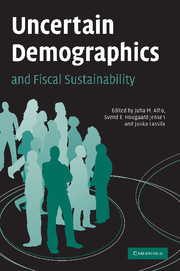Book contents
- Frontmatter
- Contents
- List of figures
- List of tables
- List of contributors
- Preface
- 1 Introduction
- Part I Uncertain demographics
- Part II Measuring sustainability in a stochastic environment
- Part III Enhancing sustainability
- 7 Evaluating pension reforms in the German context
- 8 Longevity adjustment of pension benefits
- 9 Ageing, demographic uncertainty and optimal fiscal policy
- Comment: Computable equilibrium models in policy analysis: future directions
- Part IV Extensions
- Index
- References
7 - Evaluating pension reforms in the German context
Published online by Cambridge University Press: 22 September 2009
- Frontmatter
- Contents
- List of figures
- List of tables
- List of contributors
- Preface
- 1 Introduction
- Part I Uncertain demographics
- Part II Measuring sustainability in a stochastic environment
- Part III Enhancing sustainability
- 7 Evaluating pension reforms in the German context
- 8 Longevity adjustment of pension benefits
- 9 Ageing, demographic uncertainty and optimal fiscal policy
- Comment: Computable equilibrium models in policy analysis: future directions
- Part IV Extensions
- Index
- References
Summary
Introduction
Compared to other industrialized countries, the German old-age insurance system has some special characteristics. First, the public system is very generous, offering high replacement rates at fairly low effective retirement ages. Second, since benefits are strictly linked to former contributions the system is intragenerationally fair. Finally, the system is highly centralized since the unfunded public pension system (Gesetzliche Rentenversicherung (GRV)) covers about 85 per cent of the workforce and income from funded components only amounts to about 15 per cent of current retirement income in Germany. Given these facts, it is not surprising that the German public pension system is quite expensive compared to those of other countries. Total outlays amount to about 12 per cent of GDP and the contribution rate is currently fixed at 19.5 per cent although direct government transfers already cover about a quarter of total expenditures.
In the seventies and eighties the system was almost universally accepted. However, during the last decade it came under heavy pressure in political and economic debate. One reason was the weak performance of the German economy from the mid-nineties. Rising unemployment rates and early retirement schemes decreased the contribution base and increased expenditure at the same time. The second reason was the medium-term demographic development. Due to extremely low fertility rates, Germany is ageing very fast such that the dependency ratio will almost double within thirty years.
- Type
- Chapter
- Information
- Uncertain Demographics and Fiscal Sustainability , pp. 117 - 136Publisher: Cambridge University PressPrint publication year: 2008

